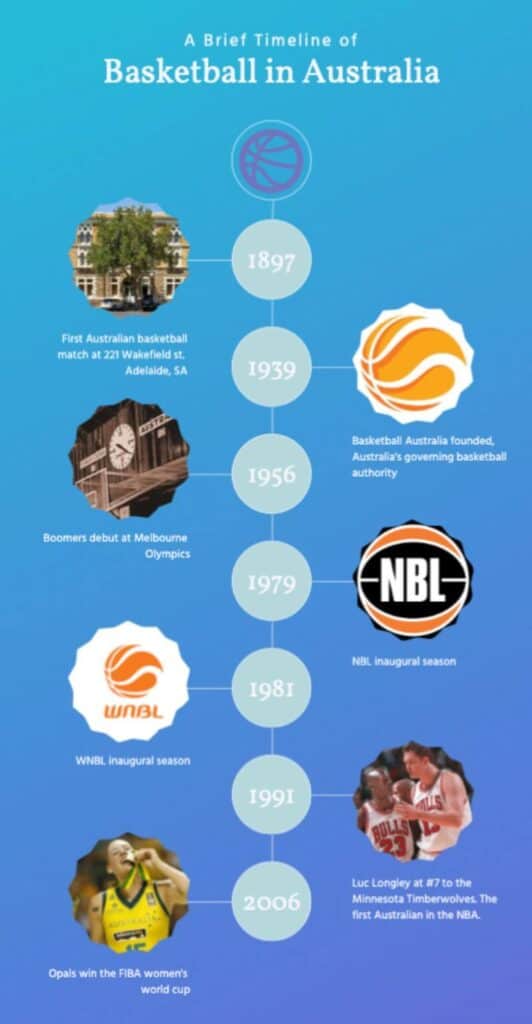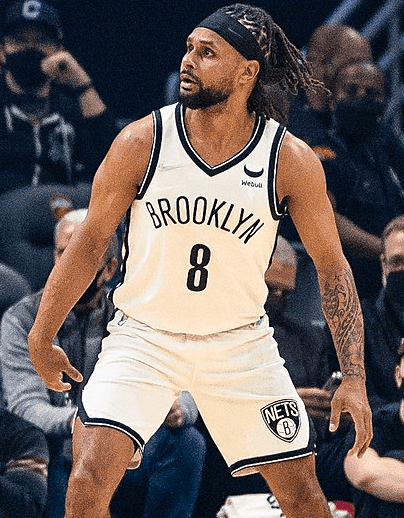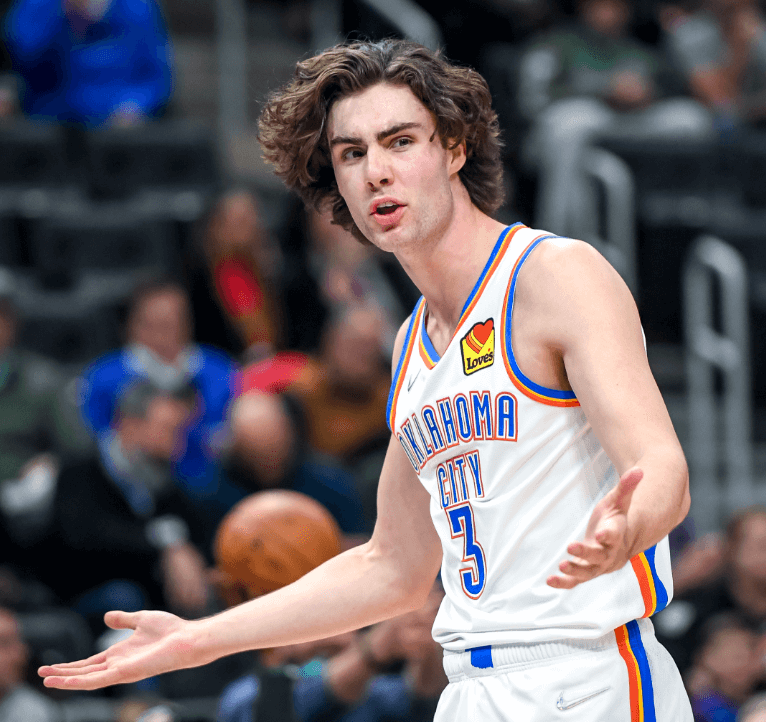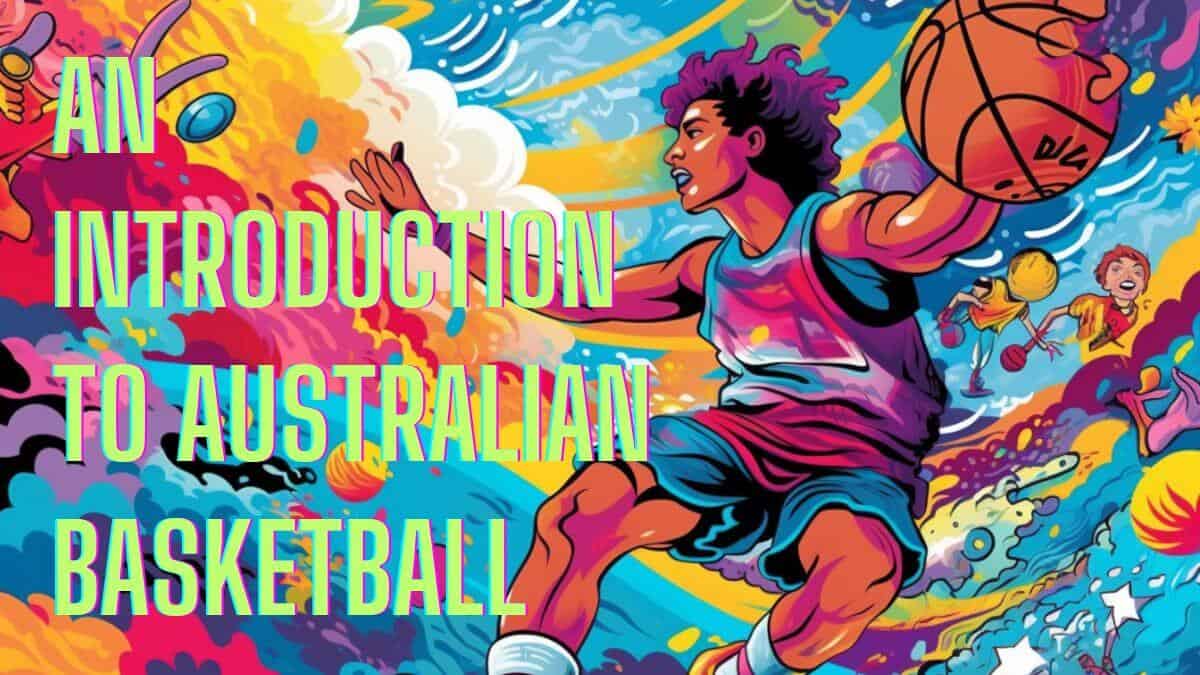Outside of the NBA, basketball is really something a little bit different. And if you appreciate hoops in a way that goes beyond the ego opera of American pro sports, you might just be game for something a little bit different.
And Australian basketball is as good a place as any to start exploring the sometimes confusing world of international basketball. Australia has a national basketball league that is increasingly popular and competitive on the world stage.
This is where we dig deep into Australian basketball. We start with some history and background. Then we’ll take a look at organized Australian basketball and the NBL. We’ll close up by introducing a few of the more notable players that have played in or emerged from Australia and New Zealand.
Let’s tip it off…
Differences between Australian Basketball and American Basketball
Let’s start with a really subjective difference. The world of Australian basketball provides a pleasant counterpoint to the NBA in that while basketball is gaining popularity in Australia and New Zealand, it takes a major back seat to a host of other sports by most measures.
This kinda means that when an Australian athlete choses to pursue basketball, they’re probably a little more likely to be in it for pure love of the game. The most impressive athletes in Australia will tend to drift towards Australia’s most popular sport, Australian Rules Football.
So, while making it in the NBL is an incredible achievement and it can be life changing for some, it’s much less lucrative than the AFL, and it’s not going to generate anywhere near the type of generational wealth that’s possible with even the lowliest of NBA contracts.
To give you a sense of the financial discrepancy between the NBL and the NBA… The salary cap in the NBL for a single professional Australian basketball team is around what the NBA pays as its rookie minimum. In 2015, a majority stake in the NBL (Australia’s pre-eminent professional basketball league) was acquired for around $7 million. That’s a majority stake in the entire league, not just a single team.
Still, the talent is there. We’re starting to see a growing population of Australian basketball players making their way into the NBA these days: Patty Mills, Dyson Daniels, Jock Landale, Jack White, Mathisse Thybulle, and the list goes on.
A Brief History of Australian Basketball

On February 23, 1897, the first official game of basketball in Australia was played in Adelaide. The game marked the opening of a youth recreational center, Our Boys Institute. The OBI boys played against the YMCA, both similarly-minded youth organizations.
A little context here, the YMCA played a major role in the early spread of basketball. The organization is often credited with the birth of basketball. It’s not entirely clear if Naismith was technically working for the YMCA when he invented basketball. However, he was certainly associated with the YMCA throughout his life.
And the YMCA embraced the sport from its early beginnings, quickly spreading basketball to its foreign outposts. There had already been games in London in 1892, and Paris in 1893.
And by 1897, only 6 years after its invention, basketball had made it’s way to the Southern hemisphere. And while the American birthplace of basketball was long ago leveled and turned into a McDonald’s, the site of the first official Australian basketball game still stands. The building, originally built to house the Our Boys Institute, is now a boutique hotel in Adelaide, known as the Adabco.
Organized Basketball in Australia
It wasn’t really until the 30’s that any organized Australian basketball clubs would emerge. In 1939, an organization called Basketball Australia was founded. This appears to be connected to the modern organization by the same name that currently overseas the majority of organized play in Australia, including the NBL and the WNBL.
There are currently 9 teams in the NBL and 8 teams in the WNBL. There’s been a fair amount of upheaval in the Australian leagues over the years. I charted the progression of teams in the NBL so you can get a quick understanding of what’s been goin on.

During the 80’s and 90’s the NBL peaked in popularity. But interest fell off in the 2000’s. It seems to be widely accepted that this was due to mismanagement and all-around poor decision making.
The Brisbane Bullets are the only team that’s remained constant in the history of the league. All of the others have had name changes, or mergers or breaks of some kind.
Today’s NBL

Today the National Basketball League (NBL) is Australia’s top pro basketball league. It’s the Aussie answer to the NBA. But the NBL is a lot less popular than today’s NBA. Think something like what the NBA was 40-50 years ago.
The NBL is only just emerging from a long stretch of disinterest from the fans. Ukrainian-born property developer and business man, Larry Kestelman, acquired a 51% stake in the NBL for only $7 million back in 2015. The league has been on an uptrend since.
The NBL is only just finally starting to retain the top Australian talent. It’s also becoming a magnet for international talent. In recent years, we’ve even seen top American prospects like LaMelo Ball and R.J. Hampton take on short contracts in the NBL before heading to the NBA. And the NBL is seen as a top destination for talent in parts of Asia and The Phillipines.
Interest is growing steadily. And the consensus seems to be that a healthy and thriving NBL is what is needed to fuel the Australian National Men’s Basketball Team (The Boomers).
And The Boomers would seem to be on their way up. In 2020, they took bronze at the Tokyo Olympics. They were rather quickly dismissed from the 2023 FIBA World Cup, but they will be looking to up their position on the world ladder at the Paris Olympics.
The Rise of Women’s Basketball in Australia
It runs deeply counter to the culture in the US, but women’s basketball is rightfully appreciated in Australia. There’s long been a strong interest in net ball in Australia. Net ball remains the most popular team participation sport in the country. That participation seems to have translated to basketball fandom.
Australia got their inaugural season of the Women’s National Basketball League (WNBL) in 1981, about a year after the formation of the NBL. Pretty impressive, considering the American equivalent (the WNBA) wasn’t a thing until 1996.
While the NBL was failing to capture interest in the 2000’s, women’s basketball was on a tear. Throughout the decade, the Australian Women’s National Basketball Team (The Opals) were a force to be reckoned with, taking Olympic silver 3 times, and FIBA World Cup gold in 2006.
Hey, they struggled with the US a little. That’s to be expected. The US has about 10x the population to cull from, and it’s where the sport was invented.
Australian Basketball Legends
A number of Australian players have left their marks on the NBL and beyond. Let’s cover a few of the most important Australian basketball players in history.
Lauren Jackson

Lauren Jackson is probably the most famous basketball player in Australia. In the US, she tends to get overlooked because we don’t pay enough attention to the WNBA. But Jackson is an icon, at her peak considered the best female basketball player on the planet, and her impact on women’s basketball cannot be overstated.
Both of Lauren’s parents played for their gender-respective Australian National Basketball Teams in the 70’s. Even with that elite pedigree, Lauren blew expectation out of the water.
At 6’5″, Lauren was a unique blend of size, agility, and shooting ability that made her unstoppable. This versatility allowed her to excel in multiple as both a power forward and a center, and she consistently showcased her scoring prowess, defensive prowess, and rebounding ability throughout her career.
Jackson was first called up to The Opals (the Australia Women’s National Basketball Team) at the age of 16. She was with the team when they took olympic silver in 2000, 2004 and 2008, as well as FIBA gold in 2006.
Her success in the Women’s National Basketball Association (WNBA) with the Seattle Storm further served to elevate her own profile as well as that of women’s basketball on the world stage.
Andrew Gaze

Gaze played a vital role in the modern development of Australian basketball. His father, Lyndsey Gaze was the founding coach of the Melbourne Tigers, the team that Andrew would go on to play with for a total of 22 seasons.
As a member of the Australian national team, Gaze competed in five Olympic Games, making him one of the most decorated Olympians in Australian history.
Following his retirement as a player, the younger Gaze transitioned into coaching like his father. His coaching stints with various teams, as well as his involvement in basketball development programs, have helped nurture young players and build a strong foundation for the future of the sport in Australia.
Andrew Gaze’s exceptional playing career, leadership, and commitment to the sport have made him an influential figure both nationally and internationally. Gaze’s contributions have not only brought recognition to Australian basketball but have also inspired countless athletes and helped establish a strong basketball culture in the country.
Luc Longley

Lucien James Longley was born in 1969 in Melbourne, Victoria but he grew up outside of Perth. His father and mother were 6’10” and 6’4″ respectively. His father had played for the Australian national basketball team in his youth. It wasn’t a stretch that Longley would become a world class center.
At the age of 17, he was picked up by the Perth Wildcats of the NBL. But Luc would only play 2 games before heading off to the US to play NCAA basketball for UNM.
At 19, Luc was playing with the Australian Boomers, grinding to a 4th place finish, the most successful Olympic run in Boomers history at the time. He would join the Boomers for multiple international competitions over the years and he counts his experiences with the National team among the most valuable of his career.
In 1990, Luc Longley was drafted at pick #7 by the NBA’s Minnesota Timberwolves. He debuted for the wolves on November 30, 1990, becoming the first Aussie to play in the NBA.
In 1994, Longley was traded to the Chicago Bulls. As their starting center, Longley would become the first Australian to win an NBA title and the only Australian at this point to have won 3 NBA titles.
Andrew Bogut
Bogut became the first Australian to go at the #1 slot in the NBA draft when he was picked by the Milwaukee Bucks in 2005.
A #1 pick doesn’t always work out as expected. Bogut worked out. He played every one of the Bucks 82 regular season games, averaging 9.4 PPG.
Bogut put up solid numbers for the Bucks in his first 7 seasons in the NBA. But he did struggle with a series of frustrating injuries. In 2012 he was traded to the Warriors.
Bogut’s scoring rate would fall off. This is quite understandable in an offense built on feeding perimeter shooters. But Bogut’s rebounding was a crucial contribution to a 2015 title run.
Andrew sandwiched multiple runs with the NBL’s Sydney Kings into his career.
Patty Mills

Patty Mills is currently with the NBA’s Brooklyn Nets, heading into his 14th season in the league. He’s also played with the Portland Trailblazers and the San Antonio Spurs (with whom he won a title ring in 2014)
Patty is just the 3rd indigenous Australian to play for the Boomers. His uncle Danny Morseau, who played on the Boomers squad in the 80’s, was the 2nd. Mills’ father is a Torres Islander and his mother is part Aboriginal Australian.
Patty is a founder of Indigenous Basketball Australia. Launched in 2020, the organization is intended to promote culture and identity amongst aboriginal youth through the game of basketball.
Josh Giddey

Giddey is one of the most promising names on this list. He’s got every bit of a chance at climbing straight to the top.
After a promising rookie season in the NBL with the Adelaide 36ers, where he became the youngest player in NBL history to log a triple-double, Giddey declared for the NBA draft. A top prospect in 2022, he was drafted to the Oklahoma City Thunder at pick #8.
And the Thunder are on a tear. This roster is stacked with some of the most impressive young talent in the NBA, and they’re playing a unique brand of basketball. It’ll take some time for this team to mature as a serious title contender, but they have a lot going for them.
Giddey is an alumnus of the NBA Global Academy which has proven a successful in driving international talent into NCAA competition and up to the NBA.
Kyrie Irving
Controversial Kyrie. One of the greatest handles of all time. And yet, I wouldn’t be surprised if Australia doesn’t want him any more than the Brooklyn Nets.
Kyrie mostly grew up in New Jersey. Still, he was born in Melbourne, so Australia gets him on a technicality.
Joe Ingles
Ingles started his career with the South Dragons of the NBL. He joined the team in heir inaugural season of 2006 and was with them when the team folded in 2009, shortly after taking their first championship title.
Ingles went on to play several seasons internationally in Granada, Barcelona and Tel Aviv. With Tel Aviv, he came away with a EuroLeague title.
In 2014, shortly after his 27th birthday, Ingles finally got picked up by the Utah Jazz where he would play for the next 8 seasons. Ingles was traded to the Milwaukee Bucks for the 2022-2023 season, in which the books claimed the 1-seed in the NBA’s Eastern Conference.
Ingles is something of a 3-and-D guy, known for a 3P% that runs around 40% and an ability to slow down some trong scorers. Ingles is known for having given Paul George a tough time when the Jazz met the Thunder in the first round of the 2018 finals.
Matisse Thybulle
I love watching Thybulle. This guy plays defense in a very unique way, and it’s fun to watch. In college, he put up some impressive stats in the blocks and steals columns.
Unfortunately, the 76ers didn’t seem to appreciate Thybulle quite as much as I do. In 2021, he led the league in steals per 100 possessions. Now with the Portland Trailblazers, they seem to be using him a little more effectively. Unfortunately, the Trailblazers are probably years away from any shot at a strong finals run.
Thybulle was born in the US, but spent a portion of his youth in Sydney and maintains dual Australian-American citizenship. He played with the Boomers in Tokyo and is likely to join them for the FIBA World Cup run in 2023.
David Andersen
Andersen has represented Australia with the Boomers multiple times over the years. Most notably, in the 2012 London Olympics, with Bogut injured, Andersen fell in as the Boomers starting center.
Andersen spent a season with the Wollongong Hawks in the late 80’s. However, he played mostly internationally throughout his career. While he was drafted in 2002 by the NBA’s Atlanta Hawks, he wouldn’t see an NBA court until 2009 when his rights were traded to the Houston Rockets.
Mathew Dellavedova
Going undrafted after graduating from St. Mary’s in 2013, Dellavedova joined the Cleveland Cavaliers for summer league and ended up with a 2-year, $1.3 million contract.
Dellavedova would get his ring with the Cavs in 2015 when Cleveland finally broke the longest pro sports title drought in American history for any city with multiple pro teams.
More recently, Dellavedova played off the bench on the most successful Sacramento Kings team in 16+ years. With the Kings dropping to the Warriors in the first round, Dellavedova hopped back to Melbourne Untied where he’s played off and on since 2021.
Takeaways
Australia is quickly developing as a serious contender on the international basketball front. The Australian national leagues are developing quickly and the national teams are improving with every major outing. The 2023 Boomers should be a team to watch in the World Cup this summer.
And the NBL in specific is a great league to follow. It’s a smaller league with fewer games than most pro leagues, so it’s not a massive time commitment. The season starts right as the WNBA season ends and just before the NBA season begins so it might help fill in some gaps in basketball programming in the fall.
